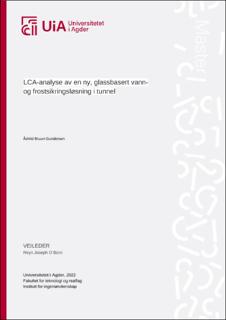| dc.description.abstract | This master thesis addresses some opportunities of reducing the environmental impacts when planning and construction of a road tunnel. It includes a LCA for two different approaches of tunnel lining; a new solution of cellular glass boards (Foamrox) compared to a traditional concept of PE-foam and shotcrete. The case study is Torsbuåstunnelen in Arendal, Norway. The conducted LCA are in accordance with ISO 14040/44 standards and focus on greenhouse gas emissions associated with the material extraction, production of materials and transportation to site. Operation and maintenance of the solutions are not included. The lifetimes of the solutions are not calculated, due to lack of information and experience of the new solution of cellular glass boards.
Norway is committed to reduce greenhouse gas emissions by at least 50 % by 2030. This study could be interesting for stakeholders working to achieve this goal, and even contractors working to reduce greenhouse gas emissions when constructing tunnels.
The global warming potential (GWP) for Foamrox-solution is higher than the traditional solution of PE-foam and shotcrete. The Foamrox solution represents 2.115,6 ton CO2-eq for Torsbuåstunnelen, and the traditional solution of PE-foam and shotcrete represents 1.224,5 ton CO2-eq. One lane in the case tunnel is 750m long, which means the Foamrox solution represent 2,8 ton CO2-eq per meter tunnel, and the solution of PE-foam and shotcrete represents 1,6 ton CO2-eq pr meter. Transport, source of energy and amount of energy got significant impact on the total GWP. The wall elements are identical in both solutions, and the total GWP could be reduced by 115 ton CO2-eq by choosing a local production. Energy consumption in production phase is the main reason why Foamrox solution have the highest amount of GWP, and an optimized solution could reduce the GWP by 483,5 ton CO2-eq for this product.
There is a lack of research studies on the new solution of cellular glass boards as insulation material for tunnel lining. This study shows that the product has potential, but some optimizations still | |
